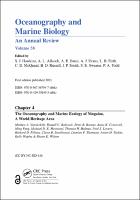Chapter 4 The Oceanography and Marine Ecology of Ningaloo, A World Heritage Area
Proposal review
| dc.contributor.author | Vanderklift, Mathew A. | |
| dc.contributor.author | Babcock, Russell C. | |
| dc.contributor.author | Barnes, Peter B. | |
| dc.contributor.author | Cresswell, Anna K. | |
| dc.contributor.author | Feng, Ming | |
| dc.contributor.author | Haywood, Michael D. E. | |
| dc.contributor.author | Holmes, Thomas H. | |
| dc.contributor.author | Lavery, Paul S. | |
| dc.contributor.author | Pillans, Richard D. | |
| dc.contributor.author | Smallwood, Claire B. | |
| dc.contributor.author | Thomson, Damian P. | |
| dc.contributor.author | Tucker, Anton D. | |
| dc.contributor.author | Waples, Kelly | |
| dc.contributor.author | Wilson, Shaun K. | |
| dc.date.accessioned | 2020-12-03T13:52:51Z | |
| dc.date.available | 2020-12-03T13:52:51Z | |
| dc.date.issued | 2020 | |
| dc.identifier.isbn | 9780367367947 | |
| dc.identifier.isbn | 9780429351495 | |
| dc.identifier.isbn | 9780367524722 | |
| dc.identifier.uri | https://library.oapen.org/handle/20.500.12657/43147 | |
| dc.description.abstract | The Ningaloo coast of north-western Australia (eastern Indian Ocean) hosts one of the world’s longest and most extensive fringing coral reef systems, along with globally-significant abundances of large marine fauna such as whale sharks. These characteristics — which have contributed to its inscription on the World Heritage list — exist because of the unique climatic, geomorphologic and oceanographic conditions. The region is hot and arid, so runoff of water from land is low, facilitating clear water that allows corals to grow close to the shore. The poleward-flowing Leeuwin Current is an important influence, bringing warm water and generally suppressing coastal upwelling. During the austral summer, strong southerly winds generate the equatorward-flowing Ningaloo Current on the inner shelf — this current facilitates sporadic upwelling events that enhance concentrations of nutrients, which in turn enhances pelagic primary productivity that supports the reef’s biota. The coast has experienced several marine heatwaves since 2011 that have caused mortality of corals, and probably seagrass, albeit relatively less than elsewhere along the coast. Wind-generated surface waves break over the fringing reef crest, causing cooling currents that tend to dampen warming — although this mechanism seems not to have prevented some areas from experiencing damaging heat, and corals in places that do not experience the wave-generated currents have experienced substantial mortality. Herbivores, from fish to green turtles, are abundant, and in the lagoon extensive stands of large brown algae provide an important habitat for newly-recruited fish. There has been a decline in abundance of some fish. Predictions of future pressures include a weaker but more variable Leeuwin Current, and increased human use. The ability of Ningaloo’s ecosystems to withstand growing pressures will depend partly on the rate and magnitude of global warming, but also on actions that manage local pressures from increasing human use. These actions will rely on continued science to provide the evidence needed to identify the pressures, the changes they create and the ways that we can mitigate them. | |
| dc.language | English[eng] | |
| dc.subject.classification | thema EDItEUR::P Mathematics and Science::PS Biology, life sciences::PSP Hydrobiology::PSPM Marine biology | en_US |
| dc.subject.other | Volume, Todd, Swearer, Smith, S, Russell, Review, P, OMBAR, Oceanography, Marine, L, I, Hawkins, Firth, Evans, Biology, Bates,B, Annual, Allcock | |
| dc.title | Chapter 4 The Oceanography and Marine Ecology of Ningaloo, A World Heritage Area | |
| dc.type | chapter | |
| oapen.relation.isPublishedBy | 7b3c7b10-5b1e-40b3-860e-c6dd5197f0bb | |
| oapen.relation.isPartOfBook | 0bf278da-435e-4b61-a3b2-a86d9bb2a5ae | |
| oapen.imprint | CRC Press | |
| peerreview.anonymity | Single-anonymised | |
| peerreview.id | bc80075c-96cc-4740-a9f3-a234bc2598f1 | |
| peerreview.open.review | No | |
| peerreview.publish.responsibility | Publisher | |
| peerreview.review.stage | Pre-publication | |
| peerreview.review.type | Proposal | |
| peerreview.reviewer.type | Internal editor | |
| peerreview.reviewer.type | External peer reviewer | |
| peerreview.title | Proposal review | |
| oapen.review.comments | Taylor & Francis open access titles are reviewed as a minimum at proposal stage by at least two external peer reviewers and an internal editor (additional reviews may be sought and additional content reviewed as required). |

